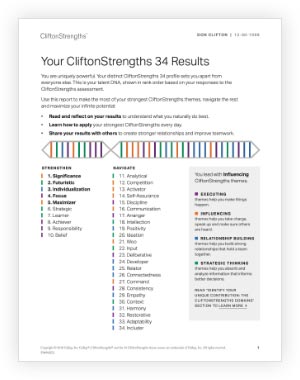Story Highlights
- A 4-1 ratio of engaged to disengaged employees counteracts the effects of disengagement
- Organizations with that ratio achieve 4x greater earnings-per-share growth
- Strengths-based development leads to higher engagement and a better employee experience
Two wrongs don't make a right, but four rights might negate one wrong.
When companies achieve a 4-1 engagement ratio -- four engaged employees for every one disengaged employee -- they reach a tipping point where engaged employees can more consistently counteract the impact of actively disengaged employees.
Companies need engaged workers because they're the ones who vastly outperform the disengaged -- organizations in the top quartile of engagement have 4x greater earnings-per-share growth, better customer engagement, higher productivity, better retention, fewer accidents and higher profitability than their competitors.
So, achieving that ratio -- and then surpassing it -- is a way to accomplish organic growth.
And how, exactly, does one go about increasing the ratio of engaged to disengaged employees? It turns out, doing so requires ongoing, intentional employee development.
An extremely effective approach to development is to focus on strengths -- strengths refer to an individual's innate patterns of thought, feeling and behavior. Strengths-based development helps people apply their strengths to increase productivity.
Many research studies allude to strengths-based development's links to engagement and productivity, but a very comprehensive Gallup study showed that strength-based development leads to:
- 10% to 19% increased sales
- 14% to 29% increased profit
- 3% to 7% higher customer engagement
- 9% to 15% increase in engaged employees
There's a connection between strengths and engagement that's fundamental to the employee experience.
Though strengths-based development can't replace engagement education or manager conversations, a strengths-based education is a powerful catalyst that managers can use to create an engaging environment for their teams.
When even one person knows and uses CliftonStrengths ...
Strengths-based development starts with first understanding what strengths contribute to performance. Every team is the sum of its parts, and different challenges call for specific abilities.
Some teams need conflict resolution, some need to be kept on task, others need to help align the work with the organizations' purpose. The people with the talent for the distinct job aspects have an intrinsic ability to do them and, when coached, do them with excellence.
When employees are explicitly encouraged to use their talent in pursuit of a goal, individual engagement improves (from 9% to 15%) as does team performance and the company's business metrics as well.
Indeed, Gallup studies have found 8% to 18% performance improvement and 2% to 10% increases in customer engagement among strengths-based organizations. Companies like those leave the desired 4-1 ratio in the dust. Their ratios are closer to 8-1. Even 11-1 or higher.
Organizations benefit when even one person -- or one team -- knows and uses CliftonStrengths, but Gallup research has shown that the benefits significantly increase when organization-wide strengths interventions (including education and coaching) are deployed. These benefits include the aforementioned marked gains in sales, customer metrics and profit, and significant reductions in employee attrition.
To reach the 4-1 ratio and then surpass it, leaders should:
- Use an employee engagement approach that is simple, clear and involves employees. The measurement needs to be about things they can control day-to-day.
- Make sure employees can be specific about what they do best and what makes them unique. Increase their self-awareness about their unique strengths and how they can apply them.
- Build manager competence for coaching, specifically coaching employees around what their strengths are and how to leverage them for success.
- Change and complexity demands more and better conversations. Make such conversations -- particularly coaching conversations -- an expectation in the workplace among peers and partners and among leaders, managers and employees. Hold people accountable.
Organizations benefit when even one person -- or one team -- knows and uses CliftonStrengths, but Gallup research has shown that the benefits significantly increase when organization-wide strengths interventions (including education and coaching) are deployed.
Make coaching conversations more effective.
Clearly, getting the optimal engagement ratio is not effortless. And the truth is, to succeed in this effort managers can't ever stop trying. Engagement is never complete -- it's made fresh every day.
But managers who engineer the employee experience around strengths find it much easier. One Gallup study found a 60-to-1 engaged employee-to-disengaged employee ratio with managers who focused on strengths, and a 2-to-1 ration of engaged to actively disengaged employees when managers focused on weaknesses.
Where managers ignored both strengths and weaknesses, employees showed a 1-to-20 ratio of engaged employees to actively disengaged employees.
While a strengths focus won't replace the importance of having ongoing coaching conversations, it does give managers a leg up on engagement. It amplifies the "I care about you" message that is implicit to an engaging management style. And it directs performance toward excellence.
People want to feel they're performing with excellence. And managers who focus on strengths create the conditions that allow people to do so -- and contribute to high-performing cultures, too, the objective of the world's best-led companies.
For those managers, the 4-1 ratio was just the first sign they were on the right track. Whether or not they meant to -- though talented managers always mean to -- they created an extraordinary employee experience along the way.
Gallup can help you achieve a higher ratio of engaged employees through ongoing learning and development:
- Use the CliftonStrengths assessment with your team or entire organization.
- See how our learning platform can help you embed strengths into your culture.
- Learn how we can partner with you to create a culture of learning and development.





